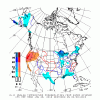packfan98
Moderator
Yeah it’s close. If it would turn up the coast a bit more at the end, it could cook up a little more. Let’s see what happens with the subsequent runs over the next couple of days. I don’t think much winter weather will happen with this one east of the mountains, but who knows?There is snow/mix in Augusta and near CHS over the 5/6th, so there's some cold somewhere













